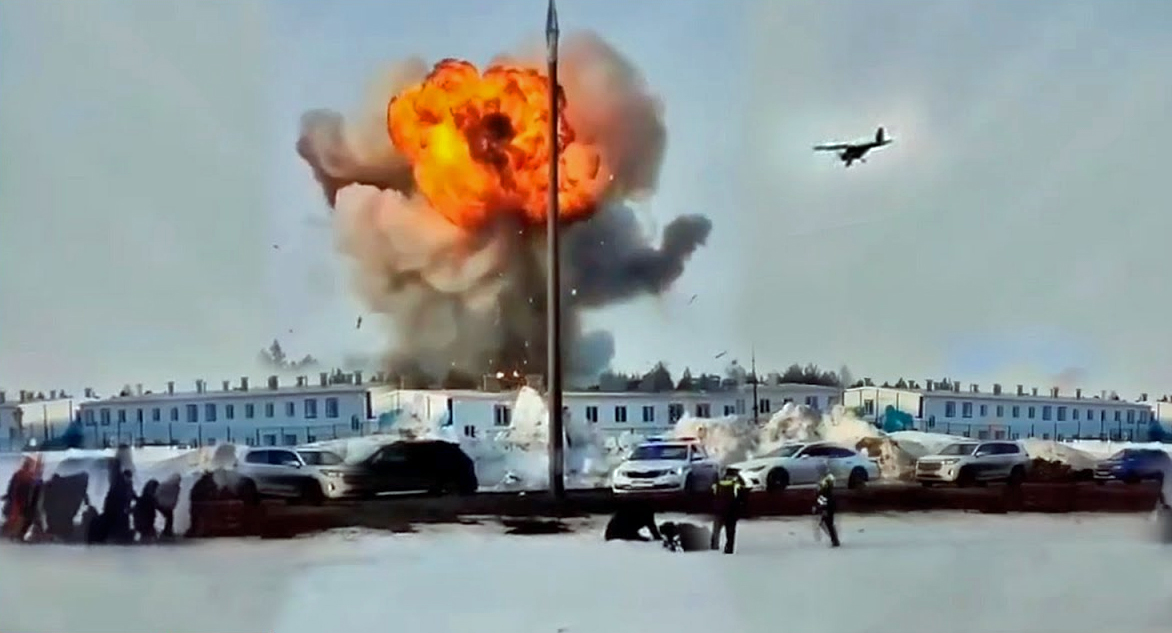Ukraine’s Main Intelligence Directorate (HUR) reported on July 27 that kamikaze drones had attacked Russia’s Olenya airfield, with one striking and damaging a TU-22M3 long-range supersonic strategic bomber and missile carrier.
The location is a base for Russian strategic aviation that lies on the Kola Peninsula within the Arctic Circle near Murmansk. It is about 200 kilometers (125 miles) from Russia’s border with Norway, 150 kilometers (100 miles) from Finnish Lapland and some 1,800 kilometers (1,125 miles) from Ukraine.
JOIN US ON TELEGRAM
Follow our coverage of the war on the @Kyivpost_official.
In an interview with Radio Svoboda on July 30, HUR spokesperson Andriy Yusov responded to questions about the operation, in particular relating to inconsistencies raised by some mainstream and social media which challenged the validity of the earlier claims.
Timing
According to Yusov, although a report of the operation was issued on July 27, the drone strike had actually taken place at 3:47 pm on the afternoon of July 25. He put the delay to Ukraine’s declaration down to the HUR wanting to verify all details relating to the event but did not confirm (or deny) any HUR involvement.
Several media outlets referred to open-source satellite imagery that showed several of the aircraft, including Tu-22M3s that had been parked at the Olenya airfield on July 25, no longer present on July 27. This is when it was originally thought the attack had occurred and they said that there was no evidence of an explosive attack.

North Korean Troops Face Major Losses in Kursk: The Cost of Russia’s Desperation
The Radio Svoboda journalist asked about the apparent absence of the evidence of an explosion on the images to which Yusov said that satellite images are “not the only source of information that should be relied on.”
He went on to say that while satellite images are a very important source of information, the HUR had consulted various sources.
Explanation for the absence of strike evidence
Yusov said that the long-range drone used in the attack was carrying a new type of air-bursting warhead specifically designed to release multiple fragments above aircraft standing in the open. An expert writing on the Defense Express military issues website said that the effectiveness of such a warhead against unprotected targets would be much higher than those carrying a contact-fused unitary explosive warhead of similar weight.
The specialist said this would also explain why relatively low-resolution commercial satellite imagery might not show any obvious evidence of an explosion or strikes on the aircraft. He highlighted the availability of airburst fusing for ATACMS and Tomahawk cruise missile warheads.
Was a Russian TU 22M3 damaged?
According to Yusov, two bombers with the tail numbers 31 and 33, that were parked close to one other, were damaged after being struck with fragments from the airburst. He also claimed that no air alarm sounded at the airfield during the attack which prevented any defensive action being taken.
He said: “I can report that we are talking about damage to Tu-22M3 aircraft... plane number 33 has holes in the upper part of its fuselage and number 31 has damage to the tail.” He suggested it could take several months before the aircraft would be repaired.
In his daily video address on July 28, President Volodymyr Zelensky made reference to the attack and seemed to confirm HUR involvement, saying:
“I want to celebrate today our soldiers who ensure Ukrainian long-range capability. In particular, the 9th department of the HUR: accuracy at a distance of almost 1,800 kilometers from our border. Really very important! Thank you for that. I also thank our SBU soldiers.
The president added: “…each destroyed Russian airbase, each destroyed Russian military aircraft – whether on the ground or in the air – means saving Ukrainian lives. Guys, our warriors, I thank you for your precision!”
You can also highlight the text and press Ctrl + Enter






